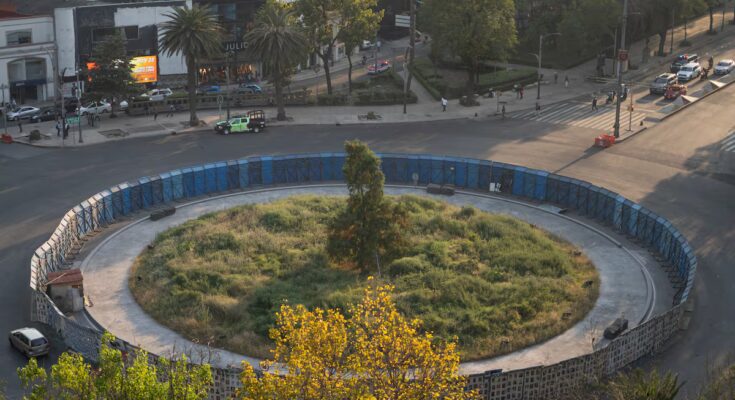He was 20 years old when he arrived in Mexico City. It weighed 10 tons and measured 12 meters. The reception, on June 5, 2022, was worthy of the treatment reserved for a first-rate dignitary. Claudia Sheinbaum, then head of the capital’s government, hailed him as a representative of the “fight for justice and peace” and asked to remember him as a witness to the “greatness of Mexico”. The words of the current president have set the bar very high. The recipient of that rosary of praise was an ahuehuete, a native tree that in the Nahuatl language means “old man of the water,” in reference to its longevity and tendency to grow in moist soil. They transplanted it from a nursery to a roundabout on the Paseo de la Reforma, the most characteristic avenue in the city, and so began this short story of a symbol transformed into a matter of state.
The ahuehuete did not succeed in the undertaking and since May 2023 an attempt has been made to replace it, another specimen of the same species. During the agony of the former, his survival accompanied the political battle between Sheinbaum and his opponents, eager to establish parallels between the left-wing president’s project, the so-called Fourth Transformation, and the precariousness of that tree which was losing its foliage with each passing day. The authorities did everything they could to save him, without success. At times the gamble of the local administration failed, as it wanted to replace a centuries-old palm tree affected by a fungus in 2022. The mayor announced a popular consultation to choose the new plantation and the ahuehuete option, with almost 80,000 votes, won over others such as a jacaranda or an ash tree.
The installation of the first tree, despite the laudatory reception, was a compendium of the efforts of a magnetic but unpredictable city. Two days later, a vehicle crashed into the roundabout. Months later, a man poured concrete around the perimeter of the second floor and was arrested. Due to exposure and vulnerability, the lawn is now protected by a circular fence. At the same time, this barrier distances neighbors and passersby from its renewed symbol and makes it difficult to observe the growth of the ahuehuete.
The square, a stone’s throw from the Angel of Independence, another emblem of Mexico City, has been renamed Glorieta del Ahuehuete, but also Glorieta de las y los Desappeared. The space was occupied by activist groups as the diseased palm tree was removed and the impromptu erection of a memorial began. In a country that this year has exceeded the chilling figure of 125,000 missing people, according to official data, any desire for justice and peace, such as that underlined by the president, must pass through the recognition of the pain of the victims.
“The Glorieta dei Desaparecidos is the place where every family will be able to place the photograph of their missing loved ones. It will continue to be a space of waiting and memory against the disappearance”, declared their loved ones at the time, who wanted to give a name to the tree. The Guardian: So they called this ahuehuete, invoking his protection for the women and men who are no longer there, in the vast majority of cases young people and prisoners of organized crime.
Today on the walls surrounding the gazebo there is a huge mosaic of photographs. There is Luz Adriana de las Rosa Cariaga, who disappeared in Piedras Negras, on the border with Texas, on September 5, 2021. She was 26 years old; Christian Iván González Rueda, from Veracruz, who has not been heard from since February 10, 2022; or Juana María Mendoza Contreras, who passed away in March 2021 in Guanajuato. And hundreds of other Mexican men and women. Behind the fence, the ahuehuete, which does not yet appear leafy and imposing: a plant that is much more than a tree due to the symbolic load that everyone attributes to it. A vital sign of hope in which many government opponents continue to see an outdated emblem.



